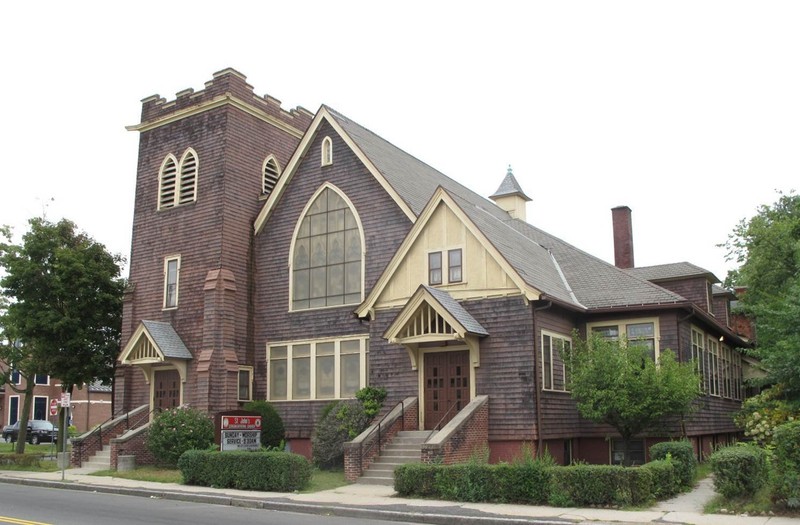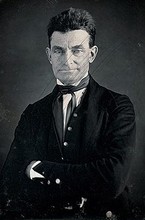St. John's Congregational Church (Sanford Street Church, Free Church)
Introduction
Text-to-speech Audio
The church now known as St. John's Congregational Church has a long and proud history in Springfield. The church is not only one of the oldest African American churches in New England, but was founded by abolitionists and was actively involved in assisting runaway slaves. For a time in the mid-1800s, the church was known as the Free Church and often hosted well-known abolitionists as speakers. John Brown attended the church during the three years that he lived in Springfield and a Bible donated to the church by Brown is on display. The church is listed on the National Register of Historic Places.
Images
St. John's Congregational Church

John Brown

Thomas Thomas, on the left

Backstory and Context
Text-to-speech Audio
The church now known as St. John's Congregational Church has occupied a central place in the history of Springfield and its African American community for generations. One of the oldest African American churches in New England, it was founded in 1844 as the Sanford Street Church. Within a few years, it was known as the Free Church, and many of its members were actively involved in the Underground Railroad and in the movement to abolish slavery.
From its inception, the Free Church was associated with prominent figures, both local and national. One of the church's founders was a personal acquaintance of Abraham Lincoln. The church's first pastor, Rev. Leonard Collins, publicly debated famed abolitionist Frederick Douglass on the issue of whether African Americans should establish their own independent churches.
Perhaps the most famous member of the Free Church was John Brown, who lived in Springfield from 1846 to 1849. Brown was already a committed abolitionist before moving to the city, which had a well-established reputation as a hotbed of anti-slavery activity. During his time in Springfield, Brown not only attended the Free Church, he was also closely associated with the African American community, becoming friends with Thomas Thomas and his family, and meeting Frederick Douglass when he visited Springfield. A rocking chair that Brown gave Thomas's mother is on display at the Wood Museum of Springfield History. The church proudly displays a Bible once owned by Brown.
In 1892, the Sanford Street Church merged with the Quincy Street Mission to form St. John's Congregational Church, which was named in honor of John Brown. By the late 1890s, the church was nationally known for its neighborhood outreach programs. Among the programs run by St. John's were night classes for women who worked as domestics and Camp Atwater, the longest continually-run camp for African Americans in the United States.
In the twentieth century, the church continued its long tradition of involvement in social justice causes by becoming involved in the civil rights movement in New England under the leadership of Rev. Charles E. Cobb. A well-educated man, Cobb led a campaign to force the Springfield School Board to end its discriminatory practice of not hiring qualified African American teachers. Cobb was also one of the first religious leaders to address "environmental racism," such as dumping toxic waste in communities where most residents were poor people of color.
St. John's Congregational Church was added to the National Register of Historic Places in 2016.
From its inception, the Free Church was associated with prominent figures, both local and national. One of the church's founders was a personal acquaintance of Abraham Lincoln. The church's first pastor, Rev. Leonard Collins, publicly debated famed abolitionist Frederick Douglass on the issue of whether African Americans should establish their own independent churches.
Perhaps the most famous member of the Free Church was John Brown, who lived in Springfield from 1846 to 1849. Brown was already a committed abolitionist before moving to the city, which had a well-established reputation as a hotbed of anti-slavery activity. During his time in Springfield, Brown not only attended the Free Church, he was also closely associated with the African American community, becoming friends with Thomas Thomas and his family, and meeting Frederick Douglass when he visited Springfield. A rocking chair that Brown gave Thomas's mother is on display at the Wood Museum of Springfield History. The church proudly displays a Bible once owned by Brown.
In 1892, the Sanford Street Church merged with the Quincy Street Mission to form St. John's Congregational Church, which was named in honor of John Brown. By the late 1890s, the church was nationally known for its neighborhood outreach programs. Among the programs run by St. John's were night classes for women who worked as domestics and Camp Atwater, the longest continually-run camp for African Americans in the United States.
In the twentieth century, the church continued its long tradition of involvement in social justice causes by becoming involved in the civil rights movement in New England under the leadership of Rev. Charles E. Cobb. A well-educated man, Cobb led a campaign to force the Springfield School Board to end its discriminatory practice of not hiring qualified African American teachers. Cobb was also one of the first religious leaders to address "environmental racism," such as dumping toxic waste in communities where most residents were poor people of color.
St. John's Congregational Church was added to the National Register of Historic Places in 2016.
Cite This Entry
Woodham, Rebecca. "St. John's Congregational Church (Sanford Street Church, Free Church)." Clio: Your Guide to History. November 21, 2018. Accessed April 2, 2025. https://theclio.com/entry/69333
Sources
Phaneuf, Wayne. Abolitionist John Brown's years in Springfield, Ma. transform his anti-slavery thoughts and actions. Mass Live. April 06, 2010. Accessed November 21, 2018. https://www.masslive.com/history/index.ssf/2010/04/abolitionist_john_browns_transformation_years_in_springfield_ma.html.
History. St. John's Congregational Church. . Accessed November 21, 2018. http://www.sjkb.org/index.php?option=com_content&view=article&id=23&Itemid=190.
Kinney, Jim. Original St. John's Congregational Church in Springfield nominated for inclusion in National Register of Historic Places. Mass Live. December 16, 2015. Accessed November 21, 2018. https://www.masslive.com/business-news/index.ssf/2015/12/st_johns_church_in_springfield_recommend.html.
History. St. John's Congregational Church. . Accessed November 21, 2018. http://www.sjkb.org/index.php?option=com_content&view=article&id=23&Itemid=190.
Kinney, Jim. Original St. John's Congregational Church in Springfield nominated for inclusion in National Register of Historic Places. Mass Live. December 16, 2015. Accessed November 21, 2018. https://www.masslive.com/business-news/index.ssf/2015/12/st_johns_church_in_springfield_recommend.html.

